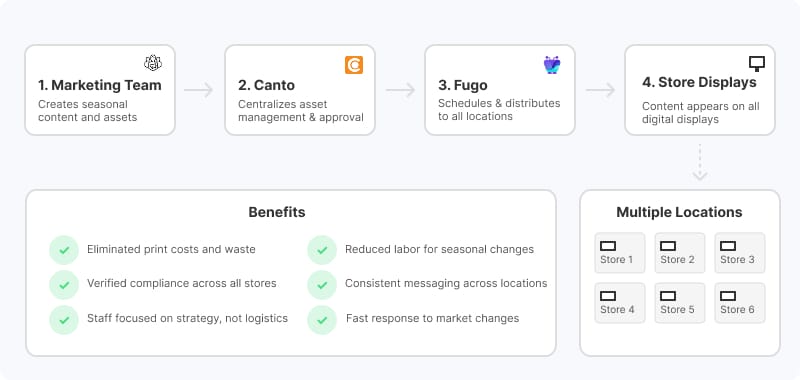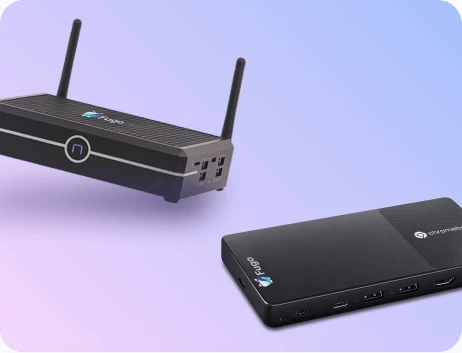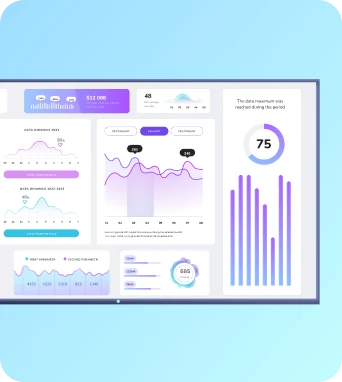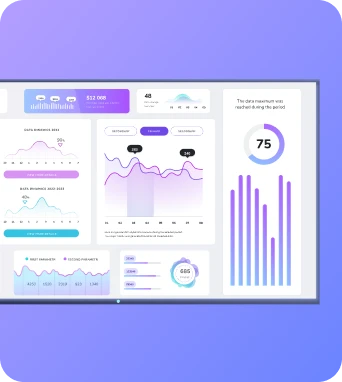Jessica, a regional visual merchandising manager for a national apparel chain, still remembers last Valentine's Day only too well. A shipping delay meant promotional materials for 37 stores arrived just 48 hours before the holiday.
Her team worked through the night, rushing between locations to swap window displays, register signage, and department headers. By the time February 14th arrived, they'd managed to update most locations - but at the cost of exhausted staff, inconsistent execution, and thousands in rush printing fees.
"The worst part wasn't even the overtime," Jessica told me. "It was knowing we'd be doing it all again in two weeks for the spring collection launch."
Now, Jessica isn't real: but if we're being honest, you probably pictured someone exactly like her at your company. That's because her fictional nightmare scenario plays out in real retail operations every season.
The universal truth remains: seasonal displays drive sales, but the logistics of managing them are stubbornly archaic at many companies.
When seasonal displays cost more than they sell
Retailers live and die by their ability to capitalize on seasonal moments. The National Retail Federation reports that holiday seasons alone account for nearly 30% of annual retail sales, with back-to-school, Valentine's Day, and seasonal transitions making up another significant portion.
When executed well, seasonal displays directly boost revenue - research from the Journal of Retailing suggests seasonal displays can increase product category sales by 10-25% depending on implementation.
Yet the mechanics behind these critical revenue drivers often rely on methods that haven't evolved since the 1980s: printed posters shipped to stores, installation instructions in three-ring binders, and regional teams scrambling to ensure compliance.

This approach creates several compounding problems:
Skilled staff spending hundreds of hours on manual updates
For a mid-size retailer with 50 locations, a typical seasonal changeover consumes 6-12 hours per store. That's up to 600 hours of highly skilled visual merchandising labor dedicated to essentially the same task: removing old graphics and installing new ones.
This leaves precious little time for what actually matters: creating compelling merchandising stories that connect with customers.
Stores displaying inconsistent messaging & pricing
Consider what often happens in multi-location retail: A district manager visits three stores in the same region on Black Friday only to find completely different signage in each. One location is using last year's promotion because they never received the update. Another has mixed old and new messaging because they ran out of materials.
This inconsistency doesn't just look unprofessional but damages customer trust when pricing or promotional messaging doesn't match across locations.
Inability to respond quickly to market changes
Retail moves at the speed of culture. When a product unexpectedly goes viral on social media or a competitor launches a surprise promotion, swift response can mean capturing - or missing - significant revenue opportunities. Traditional display systems make quick pivots nearly impossible.
How forward-thinking retailers are solving these problems
The solution to these challenges doesn't lie in hiring more visual merchandising staff or creating more elaborate shipping logistics, but in fundamentally rethinking how seasonal content reaches stores.

Digital displays - once considered luxury items for flagship locations - have reached a price-performance threshold that makes them practical for widespread retail deployment. But the hardware is only half the equation.
The missing piece that transforms these screens from expensive posters into transformative point of sale retail tools is the management system behind them.
Dramatic reduction in print costs & labor hours
Imagine an outdoor retailer with 15 locations switching to centrally managed digital displays. The potential benefits are substantial: they could eliminate up to 80% of their print marketing budget. More significantly, they might reduce the time spent on seasonal transitions from 8 hours per store to under 30 minutes.
What previously took a week of coordinated effort could happen during a morning planning session. The team would design seasonal content once, schedule it across all locations, and redirect their energy toward more creative, high-value work.
Perfect brand consistency across all locations
For multi-location retailers, maintaining brand consistency becomes exponentially more challenging with each new store opening. Digital displays managed through a central platform ensure that every location - whether it's store #4 or store #400 - delivers the identical promotional message, with the correct pricing, on exactly the right date.
Ability to respond to events within hours, not weeks
Consider what happens when an unexpected March snowstorm hits the Northeast.
A retailer with digital displays can pivot their in-store marketing from spring running gear to winter boots within hours. Meanwhile, competitors using traditional signage remain stuck promoting sandals during a blizzard.
This agility extends beyond weather events to competitive responses, inventory adjustments, and flash sales that can be deployed instantly across an entire retail network.
Creating a workflow that makes seasonal updates simple
The transition to digital seasonal displays doesn't require technological expertise. It requires workflow expertise. Retailers succeeding with this approach focus less on the screens themselves and more on creating sustainable content management systems.
The most effective implementations pair two critical components:
- A centralized asset management system that serves as the single source of truth for all approved seasonal content, brand assets, and promotional materials
- A display management platform that connects those assets to physical screens in stores, controls scheduling, and provides confirmation that content is displaying correctly
This combo eliminates the broken telephone effect that plagues traditional seasonal rollouts, where assets get modified, misplaced, or misinterpreted as they move from marketing teams to print vendors to regional managers to individual stores.
Fugo's integration with Canto creates exactly this streamlined workflow. Marketing teams upload and organize seasonal assets in Canto, then seamlessly push approved content to screens across all locations through Fugo without duplicating files, managing separate systems, or worrying about version control issues.

Where to start: first screens & templates, then results
For retailers considering this approach, several practical steps can ease the transition:
- Start with high-impact, high-turnover areas. Front windows, entrance displays, and checkout areas typically require the most frequent seasonal updates. Digitalizing these zones first delivers immediate workflow benefits while maintaining traditional approaches elsewhere.
- Build templates, not one-offs. The most successful retailers create flexible display templates that marketing teams can update without starting from scratch each season. This approach preserves brand consistency while reducing design time.
- Think beyond the calendar. Once freed from print production timelines, retailers can think differently about "seasons." A weekend flash sale becomes viable. Promotions can be tested in select locations before rolling out chain-wide. Morning messaging can differ from afternoon.
- Measure what matters. The ROI of digital displays comes not just from reduced printing costs, but from labor savings, improved compliance, faster time-to-market, and the ability to quickly optimize underperforming promotions.
The technology that makes this possible
For retailers implementing this workflow, platforms like Fugo's digital signage software and Canto's digital asset management system address the unique challenges of seasonal transitions:
Content approval workflows ensure that only finalized, approved seasonal assets reach store displays
Scheduling capabilities allow marketing teams to set up an entire year's worth of seasonal transitions in advance
Targeting features ensure that regional or store-specific seasonal content reaches exactly the right locations
Compliance reporting provides visual confirmation that seasonal displays have updated correctly across all locations
Consider what this means for a regional garden center chain with seven locations. With traditional methods, coordinating seasonal transitions between locations would take weeks. With the Fugo-Canto integration, a single marketing coordinator could update an entire spring garden display campaign, schedule it for the optimal launch date, and receive confirmation when it goes live all without leaving their desk.
Why this matters to your bottom line
The retail landscape becomes more competitive each year, with margins under pressure from e-commerce alternatives and rising operational costs. Streamlining seasonal transitions directly impacts your bottom line through:
- Reducing the labor hours dedicated to routine display changes
- Eliminating waste from discarded print materials
- Improving promotional responsiveness
- Ensuring marketing compliance across locations
- Freeing creative teams to focus on strategy rather than logistics
The retailers winning this battle aren't necessarily those with the largest budgets or the most locations. They're the ones who recognize that modernizing their approach to seasonal displays delivers competitive advantages far beyond the initial investment.
As we move through 2025 and beyond, expect to see even the most traditional retailers abandoning the print-ship-install cycle in favor of more responsive, centrally managed display systems. Those who make this transition sooner rather than later will find themselves with a significant operational advantage during the high-stakes seasonal transitions that define retail success.
Explore how Fugo's integration with Canto can simplify your seasonal display work and save staff time.





